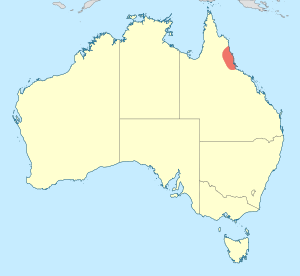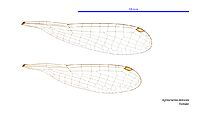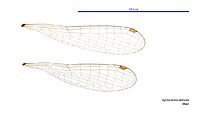Tropical wisp facts for kids
Quick facts for kids Tropical wisp |
|
|---|---|
| Conservation status | |
| Scientific classification | |
 |
The Agriocnemis dobsoni, also known as the tropical wisp, is a small and interesting type of damselfly. It belongs to the family Coenagrionidae. Damselflies are often mistaken for dragonflies, but they are usually smaller and hold their wings differently when resting.
This little insect is special because it is endemic to north-eastern Australia. This means you can only find it living naturally in that specific part of the world. It likes to live near water, making its home in pools and swamps.
Contents
What is a Damselfly?
Damselflies are flying insects that are part of a group called Odonata. This group also includes dragonflies. They are known for their beautiful, clear wings and their ability to fly very quickly. Damselflies are important predators in their habitats, helping to control populations of smaller insects.
How to Tell Them Apart
It can be tricky to tell a damselfly from a dragonfly! Here are some simple ways:
- Size: Damselflies are usually smaller and have more slender bodies.
- Wings: When a damselfly rests, it typically folds its wings together over its back. Dragonflies, however, usually hold their wings out flat to the sides.
- Eyes: Damselflies have eyes that are separated and do not touch each other. Dragonflies often have large eyes that meet in the middle of their head.
What the Tropical Wisp Looks Like
The tropical wisp is a small damselfly. It has some unique features that help identify it.
Male Tropical Wisps
Mature male tropical wisps have a special white, powdery coating on their bodies. This coating is called pruinescence. It makes them look a bit frosty or dusty. They also have a dark tip at the end of their tail, which is another helpful clue for identifying them.
Female Tropical Wisps
Female tropical wisps do not have the white pruinescence. They often have different colors or patterns compared to the males. Both males and females have two pairs of clear wings that help them fly.
Where the Tropical Wisp Lives
The tropical wisp is found only in the north-eastern parts of Australia. This region has a warm, tropical climate, which is perfect for this damselfly.
Habitat
These damselflies prefer to live near fresh water. They are often found in:
- Pools: Small, still bodies of water.
- Swamps: Wet, marshy areas with lots of plants.
They need these watery places for their entire life cycle, from egg to adult.
Life Cycle of a Damselfly
Like all insects, damselflies go through different stages as they grow. This process is called metamorphosis.
Eggs and Larvae
Female damselflies lay their eggs in or near water, often on aquatic plants. Once the eggs hatch, tiny nymphs (also called larvae) emerge. These nymphs live underwater. They are fierce predators, eating small aquatic insects and other tiny creatures. They breathe using gills, which are usually located at the end of their abdomen.
Emergence and Adults
After several months, or even years, the nymph is ready to become an adult. It crawls out of the water, often onto a plant stem. Its skin splits open, and the adult damselfly emerges. It then expands its wings and flies away. Adult damselflies live for only a few weeks or months. Their main job is to find a mate and lay eggs, continuing the life cycle.
Conservation Status
The tropical wisp is listed as "Near Threatened" (NT) by the IUCN.
What "Near Threatened" Means
"Near Threatened" means that a species might become endangered in the future. It's not in immediate danger, but its population numbers are decreasing, or its habitat is shrinking. This status helps scientists and conservationists keep an eye on the species and work to protect it before it becomes critically endangered. Protecting their swamp and pool habitats is very important for the tropical wisp.
Gallery




